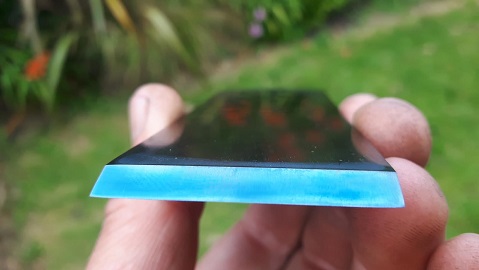gasman
Established Member
I got this years ago from eBay back when I had a constant saved search for 'casting infill plane'. It looks like a block plane, about 7 inches long, didn't come with a blade, doesn't look like it has been use much if at all although the sole and sides are fairly flat. There is a bronze 'bridge' so it is clearly intended for use with a wooden wedge. The 'insides' are all rough cast bronze - so nothing where a front bun or knob might be - and no screw hole to anchor a front knob. The slope of the blade supports is about 18 degrees or so - but it is all quite rough and ready.



So I would like to make a useful block plane out of this and I have several problems therefore to solve.
First, I don't really like wedged planes - I have made Norris-type adjusters for most of my other planes I have made - I prefer this way - plus I have a Veritas adjuster left over and I might just use that as it looks quite good size-wise and I hate wastage.

Second I need a blade. The width of the mouth aperture is about 43mm - so a 1 5/8" blade from a No 9+1/2 mitre plane would fit. I have an old blade from a Stanley mitre plane which fits and which I have drilled a 1/4" hole in for the veritas adjuster but it is only 2mm thick and would therefore chatter I think. I would like a 3 or 4mm thick blade to fit - I suppose I could make one if necessary? I cannot find much online at first glance which would be suitable
Third, if I am going to get rid of the bridge and fit an adjuster, then I need to make a lever cap, or similar to apply pressure and hold the blade. I think that is a tall order...
Fourth - I think it needs at least a front knob - and maybe even a rear infill to make it look pretty. I have a piece of timber which has amazing figure and has bright orange dust - not sure exactly what it is but it looks lovely... I have rough cut two pieces out as shown in the last photo

So if anyone has any good ideas for the above questions i would love to hear from you
Many thanks and regards
Mark



So I would like to make a useful block plane out of this and I have several problems therefore to solve.
First, I don't really like wedged planes - I have made Norris-type adjusters for most of my other planes I have made - I prefer this way - plus I have a Veritas adjuster left over and I might just use that as it looks quite good size-wise and I hate wastage.

Second I need a blade. The width of the mouth aperture is about 43mm - so a 1 5/8" blade from a No 9+1/2 mitre plane would fit. I have an old blade from a Stanley mitre plane which fits and which I have drilled a 1/4" hole in for the veritas adjuster but it is only 2mm thick and would therefore chatter I think. I would like a 3 or 4mm thick blade to fit - I suppose I could make one if necessary? I cannot find much online at first glance which would be suitable
Third, if I am going to get rid of the bridge and fit an adjuster, then I need to make a lever cap, or similar to apply pressure and hold the blade. I think that is a tall order...
Fourth - I think it needs at least a front knob - and maybe even a rear infill to make it look pretty. I have a piece of timber which has amazing figure and has bright orange dust - not sure exactly what it is but it looks lovely... I have rough cut two pieces out as shown in the last photo

So if anyone has any good ideas for the above questions i would love to hear from you
Many thanks and regards
Mark













































































